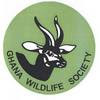Daniel, Paul, Nat and Zack having just opened the nets at the Mole ringing site

Daniel checks fat on a yellow-crowned gonolek

Paul with a green sandpiper

Grey-headed kingfisher

Lavender waxbill

On the way to the next site, Kogyae, Daniel left us to attend his lectures in Accra and we were joined by Ernestina, a graduate who will be with us for the rest of the fieldwork. Kogyae, in the central-belt of Ghana, is savanna but rather less dry and more vegetated than around Damongo. Seven transects revealed good numbers of willow warblers in the trees around the farmland, fewer pied flycatchers than further north, though some did frequent the farmland as well as the patchy teak and cashew plantations with open understories, and a few more melodious warblers in the woodland than in Damongo. Two spotted flycatchers were seen foraging in the farmland and whinchats were numerous in certain areas of open farmland, both stubble fields and burnt areas, which presumably still maintain some prey for them. Although the cohort of migrant species is similar to further north early indications suggest that there seem to be some interesting latitudinal differences in numbers of birds and the habitats they use. The ringing sites were quiet and produced two melodious warblers and a spotted flycatcher in the challenging woodland habitat.
Tina next to a tree that hosted two willow warblers in farmland near Kogyae

Mark and Tina after battling through some particularly burnt scrub

and the scrub in question...

Kogyae is a beautiful place and the reserve guards are very helpful and knowledgeable but the sun was unyielding and we were all quite relieved to see the lush vegetation and a few clouds in the sky as we approached Brenu Beach to work the coastal scrub for three days. It was amazing to see the the 500 year old colonial castles silhoueted against the Atlantic Ocean and the scale of this project becomes aparent when you think of the work being conducted all the way from here to the sahel in Burkina Faso. My first transect here displayed the difficulties of surveying for cryptic species in thick vegetation with two singing nightingales detected in the scrub between points to add to the handful of whinchats, three greenshank and one ringed plover seen along the coastal lagoon. The importance of the ringing activity was thus confirmed when the first day threw up four garden warblers, all part-way though their winter moult. It is at times like this, as I write this blog on a tropical beach with nightingales and garden warblers 50 metres away, that battling through the various challenges we have faced to collect this data all seems worth it! So one more day at Brenu Beach and onwards and upwards to Kakum and the completion of the third round of site visits. I’m not so keen to talk about the football this time…Ghana so nearly won the Africa Cup of Nations – Egypt just scraped past them in the final.
A garden warbler caught at Brenu Beach

Paul rings a laughing dove, Brenu Beach

Nat ringing a pied flycatcher in Damongo

Daniel collecting habitat data on a point count in Damongo








No comments:
Post a Comment
Note: only a member of this blog may post a comment.